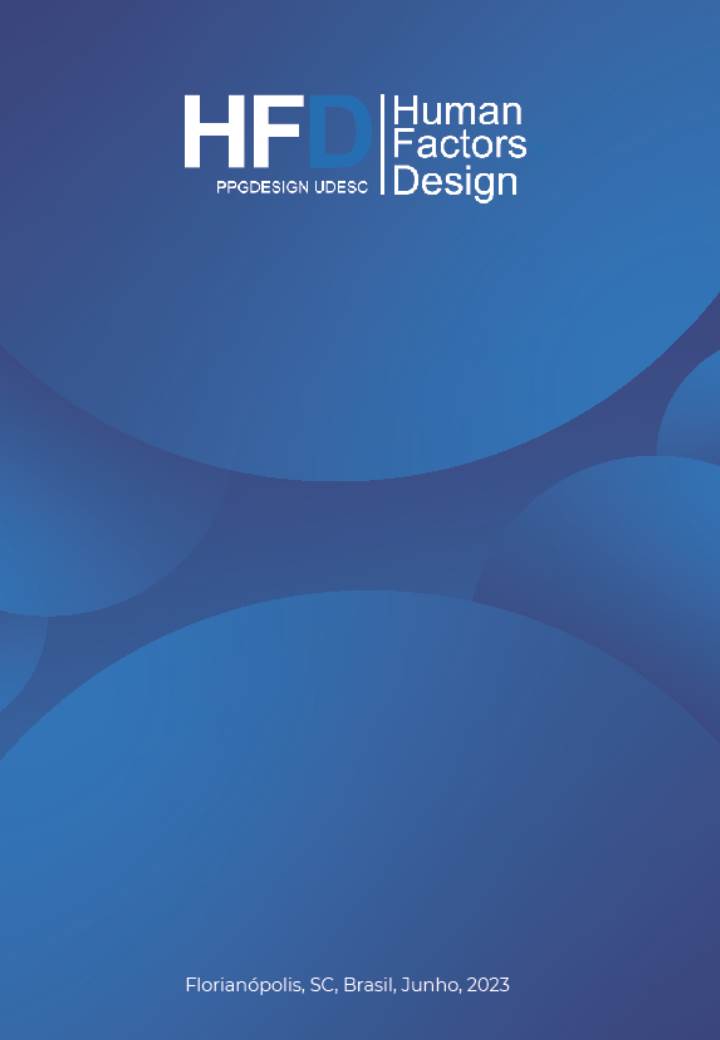Prototype of an app in augmented reality for online art exhibition emphasing colorblind
DOI:
https://doi.org/10.5965/2316796312232023032Keywords:
augmented reality, art, usability, accessibility, colorblind, user experienceAbstract
The aim of this research was to develop a prototype app in augmented reality for online art exhibition emphasing colorblind. The theoretical concepts of this research was based on the precepts of usability, accessibility. In the first evaluation step of the interface, the interview was answered by 3 artists specialists in AR. Based on this responses, implementations were conducted in terms of for usability and accessibility. In the second evaluation step, the interview was answered by 3 colorblind people. The feedback contributed to improve online art engagement.
Downloads
References
Anna Zhilyaeva. Disponível em:< https://youtu.be/7J7AeJU_MGE>.Acesso em 25, set. 2020.
AZUMA, R., BAILLOT, Y., BEHRINGER, R., FEINER, S., JULIER, S., MACINTYRE, B. Recent Advances in Augmented Reality. Computers & Graphics, v.21, n.6, p. 34-47, 2001.
BONSIEPE, G. Design: do material ao digital. Florianópolis: FIESC/IEL, 1997.
BRAGA, Marta. Diretrizes para o design de mídias em realidade aumentada: situar a aprendizagem colaborativa online. Florianópolis, 2013. Tese. (Doutorado) – Programa de Pós-graduação em Engenharia e Gestão do Conhecimento, Universidade Federal de Santa Catarina, Florianópolis.
BRIGGS, Asa; BURKE, Peter. Uma história social da mídia: de Gutenberg à Internet. Rio de Janeiro: Jorge Zahar, 2006.
CARDOSO, Rafael. Uma introdução a história do design. São Paulo: Blucher, 2008.
CGI. Disponível em:< http://www.cgi.br/sobre/> .Acessado em Jun, 2016.
Char Davies. Disponível em < http://www.immersence.com/biography/>.Acesso em 25, set. 2020.
DIAS, Cláudia. Usabilidade na Web Criando portais mais acessíveis. Rio de janeiro: Altabooks, 2007.
FARINA, M.; PEREZ; C.; BASTOS D. Psicodinâmica das cores em comunicação. São Paulo: Blucher, 2011;
Giovanni Nakpil. Disponível em < https://youtu.be/YhGg6sDTkUg >.Acesso em 25, set. 2020.
IQBAL, M.; NADEEM, A.; KHURAM, S.; NAQVI, M.; FEROZ, I. Usability aspects of adaptive mobile interfaces for colour-blind and vision deficient users. International Journal of Computer Science and Network Security, Paquistão, v.18, n.10, p 179-189, outubro 2018.
JOHNSON, S. Cultura da interface: como o computador transforma nossa maneira de criar e comunicar. Rio de Janeiro: Zahar, 2001.
Jon Rafman. Disponível em < https://jonrafman.com/>.Acesso em 25, set. 2020.
LAUREL, B. Computer as a theatre. Reading, Mass.: Addison-Wesley, 1993.
Nicola Plant. Disponível em < http://nicolaplant.co.uk/>.Acesso em 25, set. 2020.
NIELSEN, J. The Usabilitv Engineering Life Cycle. San Francisco: Morgan Kaufmann, 1994.
NIELSEN, J.; LORANGER, H. Usabilidade na web: projetando websites com qualidade. Rio de Janeiro: Elsevier, 2014.
Organização Mundial da Saúde. Disponível em: < https://www.who.int/pt >.Acesso em nov., 2022.
Rachel Rosin. Disponível em <https://youtu.be/T9chHEEp-0M>.Acesso em 25, set. 2020.
Roberta Carvalho. Disponível em < https://www.robertacarvalho.art.br/ >.Acesso em 25, set. 2020.
ROCHA, H.; BARANAUSKAS, M. Design e avaliação de interfaces-humano-computador. São Paulo: Unicamp, 2003.
Sami Akl. Disponível em < http://www.samiakl.com/artista.asp >.Acesso em 25, set. 2020.
SCOLARI, C. Interfaces: Seven Laws. USA: SLAB, 2009.
SZCZUROWSK, Krzysztofi; SMITH, Matt. Emulating Perceptual Experience of Color Vision Deficiency with Virtual Reality. In: Universal Design & Higher Education in Transformation Congress, 2018. Anais do Congresso de educação e design, Dublin Castle, p. 2-12.
UMINHO MUSEU. Breve história da Internet. Disponível em: < http://piano.dsi.uminho.pt/museuv/INTERNET.PDF>. Acessado em Jun, 2016.
VAZ, R.; FERNANDES, P.; VEIGA, A. Interactive technologie in museums: how digital installations and media are enhancing the visitors’ experience. Advances in Hospitality, Tourism, and the Services Industry, Portugal, p. 30-53, 2018.
YAMADA; V.; MARTINS, L. Indústria 4.0: um comparativo da indústria brasileira perante o mundo. Terra & Cult, Filadélfia, v.34, n. especial, p. 95-109, 2018.
WORLD WIDE WEB CONSORTIUM (W3C), 2008. Produzido por: LEE, Tim Berners.
ZAHRA, A; BREWE, S.; LAWTON, H. Essential components of mobile web accessibility. In: W4A '13: Proceedings of the 10th International Cross-Disciplinary Conference on Web Accessibility, 2013. Anais do X Congresso de Acessibilidade Web, p.1-4.
Downloads
Published
How to Cite
Issue
Section
License
Copyright (c) 2023 Human Factors in Design

This work is licensed under a Creative Commons Attribution 4.0 International License.
Os artigos publicados pela revista são de uso gratuito, destinados a aplicações acadêmicas e não comerciais. Os direitos autorais são todos cedidos à revista. Os artigos cujos autores são identificados representam a expressão do ponto de vista de seus autores e não a posição oficial da revista Human Factors Design. O (s) autor (es) se compromete a sempre que publicar material referente ao artigo publicado na Revista Human Factors Design mencionar a referida publicação da seguinte forma:
Este artigo foi públicado originalmente pela Revista Human Factors Design em seu volume (colocar o volume), número (colocar o número) no ano de (colocar o ano) e pode ser acessado em: https://periodicos.udesc.br/index.php/hfd/index


